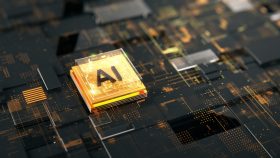Intel and NVIDIA Hook Up

NVIDIA and Intel have stunned Wall Street with news that NVIDIA will invest $5 billion in Intel and collaborate with the struggling chipmaker to create joint PC and datacenter products. And it looks as though both firms stand to benefit while shifting the balance of power in the AI market.
While the U.S. Government is investing $8.9 billion to purchase a 9.9% stake in the company, on top of $2 billion contributed by SoftBank in August, skeptics, including Futuriom, have questioned whether these investments could actually turn Intel around.
That NVIDIA isn’t just throwing money at Intel could be the determining factor in raising Intel from its self-imposed malaise. Now Intel is getting a chance to hook its wagon to NVIDIA’s AI star, instead of struggling to make inroads in a market dominated by NVIDIA and AMD.
As to terms of the agreement, NVIDIA said it will pay $23.28 per share to obtain a roughly 4% share of Intel—less than the U.S. government but still a sizable chunk of the chipmaker.
On the datacenter side, NVIDIA will work with Intel to integrate its NVLink “scale up” interconnect with Intel’s CPUs, with the result that Intel will deliver, according to the press release, “NVIDIA-custom x86 CPUs that NVIDIA will integrate into its AI infrastructure platforms and offer to the market.” On the PC side, Intel will develop “x86 system-on-chips (SOCs) that integrate NVIDIA RTX GPU chiplets." Those components will go into PCs, laptops, and mobile devices.
NVIDIA shares rose slightly on the news today, but Intel’s stock soared. By mid-morning on Thursday, shares were trading at $31.88, +7.37 (29.98%).
Shares of AMD slipped a bit on today’s news, though Broadcom’s rose slightly. Both companies compete with NVIDIA and Intel, and it’s not clear how the deal could affect their future dealings with Intel. Broadcom, for instance, was supposedly considering becoming an anchor customer of Intel’s Foundry Services, though it wasn’t pleased with Intel’s efforts to produce chips using its new 18A manufacturing process. The infusion of recent funds, plus NVIDIA's involvement, could possibly solve the process issues.
What In This for NVIDIA
While the advantages of the deal are clear for Intel, there are also benefits for NVIDIA. For one thing, NVIDIA faces rising competition: The public cloud hyperscalers, the world’s leading purchasers of NVIDIA GPUs, have been aggressively pursuing proprietary chips. As we’ve noted, as enterprises turn to cloud services for inferencing horsepower, these alternatives could significantly cut into NVIDIA’s sales.
At the same time, NVIDIA faces increasing customer concern over its proprietary ecosystem. Sales of GPUs typically require a commitment to an overall NVIDIA architecture, something enterprises find increasingly troubling—and expensive. If NVIDIA can provide solutions that increase inference efficiency, that could encourage ongoing customer adoption.
NVIDIA CEO Jensen Huang seemed to anticipate this shift in his comment for the press release:
“AI is powering a new industrial revolution and reinventing every layer of the computing stack — from silicon to systems to software. At the heart of this reinvention is NVIDIA’s CUDA architecture [emphasis added]. This historic collaboration tightly couples NVIDIA’s AI and accelerated computing stack with Intel’s CPUs and the vast x86 ecosystem — a fusion of two world-class platforms. Together, we will expand our ecosystems and lay the foundation for the next era of computing.”
In a very real sense, NVIDIA is banking on leveraging Intel’s remaining strengths to improve its future outlook.
The Fabrication Question
The deal also gives NVIDIA the benefit of a domestic manufacturing option. While its primary provider, TSMC, is forging ahead with plans to produce more chips in the U.S., its vulnerability to China’s aggressive annexation ambitions threatens its major plants in Taiwan. At the same time, NVIDIA and Intel are taking cues from the U.S. government to invest in American facilities.
However, during today's online press conference, Jensen Huang seemed to back off on any commitment to Intel manufacturing. "You can't overstate the magic that is TSMC," he said. And it seemed clear that until Intel can prove itself as a comparable foundry provider, it won't get that part of NVIDIA's business.
The Intel arrangement also comes as NVIDIA faces challenges in the Chinese market, where it seems to be losing traction, as U.S. legislators continue to question the sale of NVIDIA's chips to China, while the Chinese government discourages any purchases of NVIDIA’s H20 chips in the PRC. That said, Huang said today that the only parties involved in this deal have been Intel and NVIDIA; neither China, the U.S. government, nor SoftBank had any say or influence in the matter.
Futuriom Take: The stunning collaboration between Intel and NVIDIA could improve the fortunes of both companies, though how the deal will affect the market, including potential Intel partners, remains a question.



















